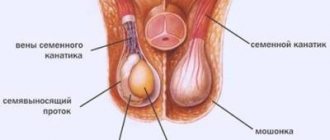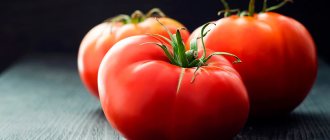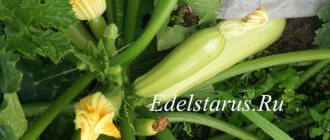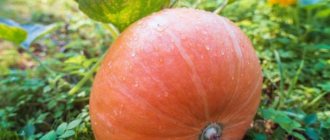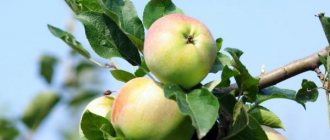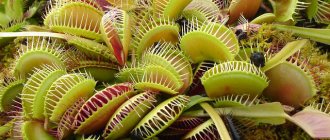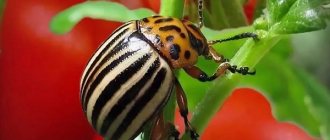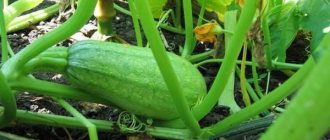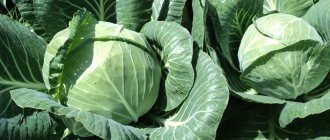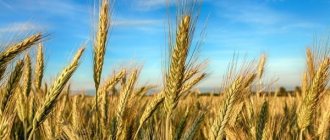- Choosing a landing site
Mid-season eggplant "Almaz" is one of the most famous and popular for several decades. Many gardeners give preference to it, despite the fact that many new varieties and hybrids have recently been developed. This success is explained by qualities that are important for vegetable crops: excellent taste, short ripening period, disease resistance, and productivity.
Vegetables are in high demand because they are small in size, have a traditional cylindrical shape and a dark purple color characteristic of the “blue ones.”
Let's look at the main characteristics of the Almaz eggplant variety in the table:
| Parameter | Characteristic |
| Culture | Eggplant (Solanum melongena L.) |
| Variety | "Diamond" |
| Ripening time | Medium: the period from emergence to technical ripeness of the fruit lasts 109-149 days (depending on the region) |
| Productivity | 2.1-7.5 kg/m2 |
| Fruit weight | 100-164 g |
| Appearance upon reaching technical ripeness | The color is dark purple, the surface is shiny (glossy), the shape is cylindrical: length 14.5-17.5 cm, diameter 3-6 cm |
| Taste qualities | Excellent |
| Disease resistance | Relative resistance to mosaic and stolbur, average susceptibility to fusarium and verticillium wilt, blossom end rot, late blight |
| Year of registration in the State Register of the Russian Federation | 1983 |
| Growing conditions | In open ground; commercial production (suitable for mechanized harvesting) |
| Recommended Regions | Central Black Earth, Lower and Middle Volga, Western Siberian, North Caucasian, Ural, Far Eastern |
| Originators | Intersemya LLC (Stavropol Territory), Agrofirm Poisk LLC (Moscow region), Nasrullaev Niyazi Mehyeddin (Moscow region) |
Historical background of breeding work
Diamond is a relatively young variety, no more than 40 years old. The culture was included in the state register of breeding successes in 1979. The creator of the variety is breeder Nasrullaev N.M. together with the Intersemya seed farm, they are patent holders.
The variety is intended for cultivation in open and closed ground in the Urals, Far East, Siberia, and the Black Earth Region.
Eggplant Almaz, according to reviews from gardeners, has proven itself on the positive side:
- disease resistant;
- productive;
- unpretentious.
Fruit characteristics
- Diamond eggplants grow up to 15 -17 cm in length.
- Each vegetable weighs on average 100-180g.
- The skin is dark purple, almost black, thin and shiny.
- The flesh is slightly greenish.
- Excellent taste.
- The calyx is without thorns, making the fruits easy to remove from the bush.
- They can be stored in the refrigerator for up to 30 days if the fruits are undamaged and packaged in film.
- Resistant to transportation.
- Universal in use.
Eggplants in the biological stage of ripening become brown. They are larger, but are not very suitable for food, since the pulp becomes coarse and the seeds are hard.
Description and characteristics of the variety
“Sinenkie” is the affectionate name for vegetables in the southern regions of Russia, where they have been grown for a long time.
Eggplant Diamond is an annual herbaceous plant. The bush is not spreading, it grows up to 50-60 cm.
- Refers to mid-season varieties. From planting to harvest at least 4 months.
- The leaves are green interspersed with purple veins.
- The calyx is glossy purple without spines.
- The fruits are small, 18-20 cm long, weighing 150-160 g, ripen on the lower part of the stem. They have an oblong shape. The skin is dense, but not thick. The pulp is juicy in taste, light with a soft green tint.
- The high yield of the variety is ensured by a large number of stepsons on the bush.
Eggplant is tasty and not bitter. Housewives use it:
- for the purpose of preparing hot dishes;
- cold snacks;
- canning.
Important!
Eggplant Diamond is not a hybrid. Therefore, there is no need to buy new seeds every year. You can collect them yourself from ripe fruits. If an eggplant of the Almaz variety is planted, then the harvest is guaranteed.
Reviews from vegetable growers
Natalya, 54 years old, Moscow region
I grow this variety at the dacha in open ground. The eggplant is excellent, the bushes are strong, do not require any garter, there are a lot of flowers, the fruits set well, they grow large and beautiful. This year the first eggplants were picked in mid-July.
Anna, 35 years old, Chelyabinsk region
I tried to grow eggplants outdoors for several years, but failed every time. This year I was advised to plant Almaz. And indeed, he grew very well in our cool climate and did not suffer from anything. I harvested in summer and autumn. The fruits are large, smooth, tasty and completely without bitterness. I planted seedlings in open ground, but did not cut off the shoots, as new eggplants grew on them.
Nina, 54 years old, Krasnodar region
For fun, I plant different varieties and hybrids of blueberries, but Almaz is my favorite, I always give it a place in the garden. It has never let me down and produces a good harvest every year. For prevention, I treat the beds against diseases and pests with herbal remedies. And so that I have my own seeds, I leave a couple of fruits until they are completely ripe. So there is no need to spend money on planting material, although it is inexpensive in stores. Eggplant is tasty, not bitter, and ripens gradually, so you always have the fruit on hand for cooking and canning for the winter.
Features of cultivation
In the southern regions of Russia, this variety of eggplant grows in open ground, but in the central and northern regions it grows exclusively under film cover or in a greenhouse.
- “Loves” fertile, light soil rich in organic fertilizers (manure, compost).
- The landing site should be well lit and protected from the wind.
- Does not tolerate heat well (when the temperature rises above 30 degrees), or a long drop in air temperature. Factors that can lead to the death of the plant, or it will shed its leaves and ovaries.
- Grow by seedlings.
Seeds begin to be planted at the very end of winter or in the first ten days of March.
- Place 2-3 seeds in separate pots. Deepen to 1 cm. Moisten the soil by spraying. If several seeds are planted in a large container, the distance between them should be at least 6 cm.
- Cover the container or pots with film and place them in a well-lit place. It is important that there are no drafts.
- The seeds will sprout in 10-12 days. The seedlings are placed in a cooler place for 5 days. At this time, strong root growth begins.
- If the seedlings are in one container, they need to be thinned out (picked) and planted in a separate container after the first leaves appear.
- After 55-60 days, the seedlings are planted in a greenhouse or in open ground if the ground has warmed up to 15-16 degrees.
In the southern regions, they are planted directly with seeds in open ground in the month of May, and in the northern and central regions - with seedlings, a month later (June).
Important! Eggplant seedlings do not like frequent replanting, they begin to get sick, and plant growth slows down. Therefore, it is advisable to plant the seeds immediately in separate containers, and not together, to avoid picking.
Before Almaz seedlings are planted, the soil is prepared.
- The soil must be thoroughly loosened and organic matter added: compost or manure.
- Make holes, keeping a distance between them of at least 75 cm.
- Plant the seedlings, deepening the roots to 7-8 cm.
- Young seedlings should not stand under the scorching rays of the sun, at least for a few days, while the plants adapt to their new location.
Features of planting and care
Reviews from summer residents about the Almaz variety eggplant insist that it is better to plant the crop in seedlings. The reason for this is simple - the duration of ripening using conventional sowing is quite long. Often, in unfavorable growing conditions, this variety may not bear fruit - it simply does not have time to ripen. Therefore, it is better to plant Almaz using seedlings.
Attention! It is recommended to plant seeds for seedlings in early February.
Planting time for seedlings
Almaz eggplant seedlings are planted 2-2.5 months after emergence. This time is set for landing under the open sky. If the variety is planned to be grown in greenhouse conditions, the optimal time would be to plant the sprouts a couple of weeks earlier.
Soil preparation
Soil for planting eggplants can be purchased at a special store. Such a soil mixture will be rich in mineral and organic fertilizers.
Soil purchased from a garden store requires virtually no disinfection, while soil from a summer cottage requires treatment.
If a summer resident has not opted for a purchased soil mixture, but has decided to collect soil from his own dacha, it is recommended to feed the soil a little with useful substances. For this use:
- peat;
- sawdust;
- wood ash;
- humus.
It is also important not only to fertilize the soil, but also to disinfect it from pests. To do this, the earth is heated in the oven.
Important! The soil heating temperature should not exceed 100 degrees.
After warming up, the soil is left to rest for 7-10 days to restore nutrients.
Preparation of seed material
You can prepare Almaz eggplant seeds yourself, or you can purchase them in the store. If a summer resident plans to collect the seeds himself, it is recommended to cut a ripe eggplant and collect the seeds with your hands. After drying the seeds, you can begin processing.
Warning! It is necessary to disinfect the seed material (after all, microbes and fungi can live on the surface).
Seed material can be disinfected using one of the following methods:
- Keep the seeds for 5-7 minutes in water at a temperature of 50-60 degrees.
- Soak for 30 minutes. in a strong composition of potassium permanganate (0.5 g per half liter of water).
- Treat with hydrogen peroxide (2 ml per half glass of water).
After processing, the grains are washed, dried and prepared for planting.
To get early seedlings, you can germinate them in a warm room in a damp cloth.
Purchased seed material, which is in a protective colored shell, cannot be processed or germinated.
Planting seedlings
To perform the procedure correctly, you should use the agrotechnical planting method:
- prepare a spacious box for seedlings;
- plant the seeds to a depth of 1.5 cm;
- cover with plastic and place in a warm place until germination;
- After germination, transplant the sprouts into separate 10 x 10 cm containers.
Important! It is necessary to plant strong and healthy sprouts in cups; it is better not to use weak seedlings.
Sprout care
It is very important to ensure regular watering for planted seedlings. The soil with sprouts should be moderately moist; the soil should not dry out.
It will be important to provide good lighting to the sprouts. If there is a lack of sunlight, you should use a phytolamp.
When the seedlings grow, you can reduce watering - once every 3 days will be enough. For watering, use only settled, slightly warm water.
Attention! Cups for seedlings must have holes for drainage.
The period of complete ripening of seedlings is about 2 months, so it is important to provide eggplants with nutrients. The first feeding is carried out 14 days after planting in plastic cups. Subsequent fertilization should be done every 2 weeks.
Hardening
Any seedling needs hardening. Such plants take root better and tolerate sudden changes in temperature more easily. 7-10 days before planting in an open garden bed, you can begin to harden off the sprouts. The procedure is performed gradually. The sprouts are taken outside for 1 hour at first, constantly increasing the time until the whole day.
Attention! On a warm day, moisten the seedlings more often; on cool and rainy days, hide them under a canopy.
Preparing the bed
3 weeks before planting seedlings in the soil, the bed should be dug up and fed. Some summer residents prepare the site in the fall. Black Diamond eggplant loves loose, fertile soils. Therefore, per 1 m2 you should add a bucket of compost and 2 tbsp. ash.
Landing
When planting eggplant in a greenhouse, Almaz is planted next to the tomatoes. It is very important to place the plants so that both crops receive enough light.
Planting in an open garden bed is carried out according to the following principle:
- A day before planting the seedlings, water the sprouts generously so that when removing the root from the soil, you do not damage it.
- Dig small holes in the area and fill them with water.
- After absorbing moisture, plant one sprout along with a lump of soil, sprinkle with soil, compacting slightly.
- After planting all the bushes, mulch with straw.
The correct planting of Almaz eggplant in a greenhouse can be seen in the photo:
Care after planting in a greenhouse or open ground
If Almaz eggplant seedlings have taken root in a permanent place, care for the crop is minimal:
- the plant is watered;
- loosen;
- fed.
Water for the first time after planting 10 days later. Daily watering is not required; watering the plant twice a week is sufficient.
The soil is loosened to provide air to the root system, and weeds are removed, as they can cause eggplant diseases:
- rot;
- viruses;
- fungi.
Feed the eggplant bushes 3 times.
- Urea half a month after planting at the place of growth.
- Urea + superphosphate - in a month.
- When the fruits appear, they are fed with cow dung.
- If there are few ovaries, you can add potassium.
In case of insufficient pollination of flowers, pollinating insects are specially attracted. For this purpose, a sweet solution is sprayed onto the bushes, for the preparation of which you will need:
- boric acid - 2-3 g;
- sugar - 100 g;
- hot water - 1 l.
The need to plant the Almaz eggplant is a controversial issue. Gardeners do not have a consensus on this matter.
Nuances of crop care
Caring for Almaz eggplants is not particularly difficult; nothing extraordinary is required from the gardener. But like all crops, there are certain nuances of agricultural technology that you need to familiarize yourself with in advance. In addition to keeping the garden bed clean and regularly loosening it, the gardener will need proper fertilizing and sufficient watering.
In especially productive years, Almaz eggplants may require a garter or support. The root system of plants is quite fragile, as are the stems. Bushes often break under the weight of the fruit.
When cultivating in a greenhouse, it will be necessary to provide access to insects. Or pollinate by hand. Without this, Almaz will not bear fruit.
Gardeners have different opinions regarding the need to form Almaz eggplant bushes. Most believe that compact plants need pinching only if the weather has been cool for a long time and it rains frequently.
Quite a long growing experience shows that in the south of Russia the Almaz eggplant bears fruit abundantly without any formation of a bush. In regions with a temperate climate, the bush is turned into a standard one, completely exposing the trunk up to the first fork. This applies to both leaves and stepsons. Due to the short stature of eggplants, they often touch the ground, which increases the risk of infection by pathogenic fungi.
Stepchildren are side shoots that form in the axils of eggplant leaves.
However, you shouldn’t be too zealous with pruning - this variety also forms ovaries on the stepsons. 2-3 stems are left on each bush; it should not be allowed to branch intensively, so that unnecessary shoots do not draw strength from the plant.
To ensure that the fruits ripen faster and are larger, a maximum of five eggplants are left on each plant at a time. As soon as the required number of ovaries is formed, the top of the bush is pinched. The flowers that appear at the top are regularly removed.
Eggplant Almaz tolerates drought well, but obtaining a bountiful harvest is only possible if it is provided with sufficient watering. In general, this is the most moisture-loving crop of all Solanaceae. Therefore, only the top layer of soil is allowed to dry, moistening the substrate every three days. If there is extreme heat, plants generally require daily watering. The fact that the bush lacks moisture is clearly indicated by drooping leaves that lose their tone.
It is not recommended to water eggplants from a watering can; other methods in which drops of water fall on the plant are also excluded.
Water the eggplants so that drops of water do not fall on the plant. This can cause massive loss of buds and fruit ovaries. And if they are planted in a greenhouse, the drops turn into some kind of lenses, and the plants receive serious burns. Accordingly, dousing the bushes with a watering can, hose and sprinkling is immediately eliminated. The most suitable method is drip irrigation. After all, if you pour water directly under the base of the stem, the soil quickly erodes and the roots dry out in the open air. When it is not possible to build such a system, water is poured into shallow longitudinal grooves or circular grooves with a diameter of 30–40 cm.
The drip irrigation system helps to deliver water “targetedly” to the eggplant roots
Each plant requires 2–3 liters of water (or 10–12 l/m²). It must be settled and heated to a temperature of at least 25°C. The soil needs to be wetted approximately 20–25 cm deep. Early morning is best for watering. It is especially important to provide plants with moisture during flowering and the formation of fruit ovaries. Ripening fruits need it no less. For gardeners who visit their own plot only from time to time, it is advisable to loosen the soil and renew the layer of mulch after each watering. This helps retain moisture in the soil.
Mulching eggplant beds helps gardeners save time on watering and weeding
Interestingly, Almaz has a negative attitude towards high air humidity. Accordingly, when cultivating in a greenhouse, you will have to monitor this. A comfortable indicator for eggplants is 60–65%. Every time after watering, be sure to open the windows. If a container of water is in a greenhouse, it is covered with a lid.
The requirements for soil and air humidity for eggplants vary radically; the latter indicator must be monitored especially carefully in the greenhouse
Video: caring for eggplants in open ground
The Almaz variety is a mid-season variety. During the active growing season it is fed 3-4 times. For the first time this is done no earlier than two weeks after planting the seedlings. She must have time to settle down in a new place and begin to grow. Bushes actively growing green mass need nitrogen, but it is better to use complex fertilizers (Azofoska, Diammofoska, Nitrophoska) instead of urea, ammonium nitrate, ammonium sulfate (10–15 g per 10 l) and so on. A natural alternative to such remedies is an infusion of fresh manure, chicken droppings, nettle or dandelion leaves.
Nettle infusion allows you to provide eggplants with nitrogen without oversaturating the soil with this macroelement
The second and third feeding is carried out when the first flowers appear on the Almaz eggplants and approximately 15–18 days before the first fruits are harvested. Preparations based on vermicompost and any complex fertilizers for Solanaceae are used accordingly. It is also useful to spray the bushes with a solution of boric acid (2-3 g/l) about once a month - the ovaries become stronger.
Almaz eggplants can be fed with any fertilizer for Solanaceae
Ripening eggplants have a vital need for potassium. To extend the fruiting period as much as possible, wood ash is scattered over the garden bed. If there is little rainfall, the plants are watered with its own infusion. Mineral fertilizers can include potassium sulfate, potassium nitrate, and potassium magnesium.
Wood ash is a natural source of potassium, necessary for ripening eggplants and extending the fruiting period
Video: nuances of growing eggplants in a greenhouse
Of the diseases for Almaz eggplant, the most dangerous are fusarium and late blight. Their prevention should be given special attention when planting plants in a greenhouse. High humidity, heat and stale air are very suitable for the development of many fungi.
Fusarium wilt most often affects eggplants in the southern regions. It develops very quickly. In just 4–7 days, the leaves of an absolutely healthy-looking plant turn yellow and wither, the base of the stem becomes covered with a pinkish coating, the bush dries out and in most cases dies. Surviving specimens are greatly retarded in growth, there are almost no fruits on them or they are very small. Fusarium can be distinguished from ordinary wilting due to moisture deficiency by cutting the stem or petiole. In the first case, dark brown dots are clearly visible.
Fusarium wilt develops rapidly, thereby depriving the gardener of the chance to successfully fight it
It will not be possible to fight fusarium because of its transience. For prevention, seeds must be treated in a fungicide solution before planting. During the loosening process, the soil in the garden bed is sprinkled with ash or crushed chalk; ordinary water for irrigation is alternated with a pale pink solution of potassium permanganate. A folk remedy is a piece of copper wire wrapped around the base of the stem or buried in a hole when planting.
Late blight is a real scourge of any Solanaceae. Inconspicuous lime-colored spots appear on eggplant leaves. Gradually, the tissues in these places turn black and dry out, leaving only a bright border. If it is damp and cool outside, the underside of the leaf becomes covered with a layer of whitish cotton-like coating. Black seals of irregular shape appear on the fruits, and the tissues underneath rot.
Late blight is a disease characteristic of all Solanaceae; it can develop both when growing eggplants and during storage.
To prevent late blight, the same measures are suitable as for fusarium. Additionally, you can spray the eggplants with an infusion of onion or garlic gruel or arrowroot once every 1.5–2 weeks. Kefir diluted with water or whey with added iodine gives a good effect. Leaf mustard, clover, and marigolds are planted next to the eggplants and between the rows. To destroy the fungus, use the drugs Abiga-Pik, Ridomil-Gold, Baktofit, Zineb.
Blossom rot is not a disease, but an eggplant reaction to potassium deficiency. The Almaz variety is very sensitive to this. Round greenish spots appear on unripe fruits. Gradually they increase in diameter and darken. If you fertilize, the condition of the plants will quickly return to normal. After it, it is recommended to increase the watering rate for the plants for 15–20 days.
Blossom rot of eggplants indicates that the plants do not have enough potassium.
It is a mistake to think that the Colorado potato beetle is dangerous only for potatoes. This pest, which all gardeners have probably seen, feeds on the foliage of any Solanaceae. Therefore, compliance with crop rotation is of paramount importance for prevention. Traps have a good effect - containers dug into the rows filled with pieces of chopped potatoes or their peelings. Eggplant bushes are sprayed weekly with infusions of wood ash, soda ash, and horsetail rhizomes. Calendula, garlic, and bush beans planted between rows repels the pest. In the event of a massive pest invasion, biological products (Bankol, Boverin, Colorado) or chemicals (Decis, Corado, Aktara) are used.
Absolutely all gardeners know what the Colorado potato beetle looks like.
Resistance to diseases and pests
Although the Almaz variety is positioned by its creators as resistant to various diseases, improper care can lead to the plant getting sick or withering away. It may be affected.
- Late blight. White spots appear on the leaves. The bush will die.
- The appearance of black dots on the plant indicates that the cruciferous flea beetle is eating the greens. It can completely destroy a seedling.
- When the soil is waterlogged - black leg. It can lead to the death of the plant.
- The formation of an unusual pattern on leaves and fruits indicates a disease - a mosaic.
To protect eggplants from diseases, you need:
- proper seed preparation;
- cotyledon leaves should remain above the ground;
- constant plucking of diseased plants;
- water with non-cold water.
Of the pests, the Colorado potato beetle is especially dangerous. You can fight him the old fashioned way. Collect by hand. You can spray it with a product (there is a wide choice in the store) against this pest.
How to preserve the harvest
Cut eggplants when they grow to the typical size of the variety - 14–18 cm. Remove the lowest fruits touching the ground as early as possible, otherwise they may rot. In addition, by removing the first fruit, you stimulate the bush to form new ovaries. Diamond can be stored fresh in the refrigerator for about a month. But to do this, take the fruits without the slightest damage and pack them in film. Eggplants are stored in the freezer until the next harvest. Moreover, you can make the same dishes from frozen ones as from fresh ones, but they cook faster.
Before freezing, eggplants can be cut into pieces or plastics; in winter, all you have to do is take them out and throw them into a saucepan or frying pan.
Advantages and disadvantages of the variety
Despite the love of gardeners for the Almaz variety, in addition to its advantages, it has a number of disadvantages.
| Advantages | Flaws |
| Not a hybrid. | It is often affected by late blight and blossom end rot. |
| Rich harvests, 8.5 kg per 1 sq.m. | The pulp contains many seeds. |
| Pleasant taste of fruits, not bitter. | The fruits appear at the bottom of the bush. Sawdust or straw will help avoid rotting from contact with the ground. |
| The variety is resistant to climate change (drought, etc.). | |
| There are no thorns on the calyx, making it easier to harvest. | |
| They are transportable because they have a dense and strong skin. | |
| Suitable for cooking and preservation. | |
| They are stored for a long time. |
Description of the plant
The bushes are quite compact, reach a height of 45-56 cm, and are characterized by early branching. The leaves are green with greenish-violet venation, broadly oval in shape, medium in size, slightly indented at the edges. The leaf petiole is green. The calyx is green-violet, spines . The corolla is characterized by a light purple color. The fruit is cylindrical in shape with a shiny surface, the color is dark purple during the period of technical ripeness, and upon the onset of biological maturity it becomes brownish-brown, length is in the range of 14.5-17.5 cm, diameter is 3-6 cm, weight is from 100 to 164 g. The pulp is dense, slightly greenish, there is no bitterness, the taste is excellent.
Fruit set at the bottom of the plant may touch the soil surface
Early ripening and productivity
The variety has a medium ripening period and is recommended for cultivation in open ground. The growing season from the appearance of the first shoots to harvest ranges from 109 to 149 days (depending on the region).
Productivity also varies and ranges from 2.1 to 7.5 kg per 1 m2. The tendency of plants to branch together and early contributes to high yields.
With industrial cultivation, the yield is 35-40 t/ha; the variety is valued for its suitability for mechanized harvesting
Studies have shown that for food use, it is best to pick 35-day-old eggplant fruits, since during this period they contain the maximum amount of useful substances.
Vegetables are perishable; in uncooled conditions they are stored for no more than two days, and in the refrigerator at a temperature of 1...2 ℃ and air humidity of 85-90% - up to 25 days.
Sustainability
The plant is relatively resistant to such common diseases as mosaic and stolbur. Moderately susceptible to late photoblight, fusarium and verticillium wilt, as well as blossom end rot.
Late blight is considered one of the main problems when growing nightshades - various ways to combat late blight are described in detail in an article on our website
Reproduction methods
There are 2 known methods of propagating eggplants:
- The plant is most often propagated by seeds. To obtain seed from your harvest, you need to pick ripe fruits and leave them to ripen in a warm place for 10-15 days. After this, they are cut, the seeds are removed, washed and dried. They are stored in paper packaging for 5 years.
- Growing from cuttings is suitable for those who dug up fruit-bearing plants in the fall and planted them in pots for later growing at home.
Sequencing:
- Small cuttings are cut from an eggplant bush.
- Place in a jar of water (no more than three pieces).
- When roots appear (after 2 weeks), they are placed in deep containers with soil.
- After the onset of warm weather, they are planted in open ground using the transshipment method (while preserving the earthen clod).
Tips and tricks
Experienced gardeners with extensive experience in growing eggplants know many secrets of obtaining an excellent harvest, which they share with beginners.
Tips for gardeners:
- Avoid planting eggplants next to potatoes to avoid attracting Colorado potato beetles.
- Sprinkle the soil with ash and moisten it - Colorado potato beetles are repelled by the smell of wet ash.
- It is better to plant seeds for seedlings immediately in separate glasses, so as not to replant the seedlings again.
- You should not wait for the fruits to fully ripen. Harvesting begins when the fruits reach varietal size. Over time, the fruits become coarser and the seeds harden.
- To reduce the frequency of watering outdoors, you need to mulch the soil.
